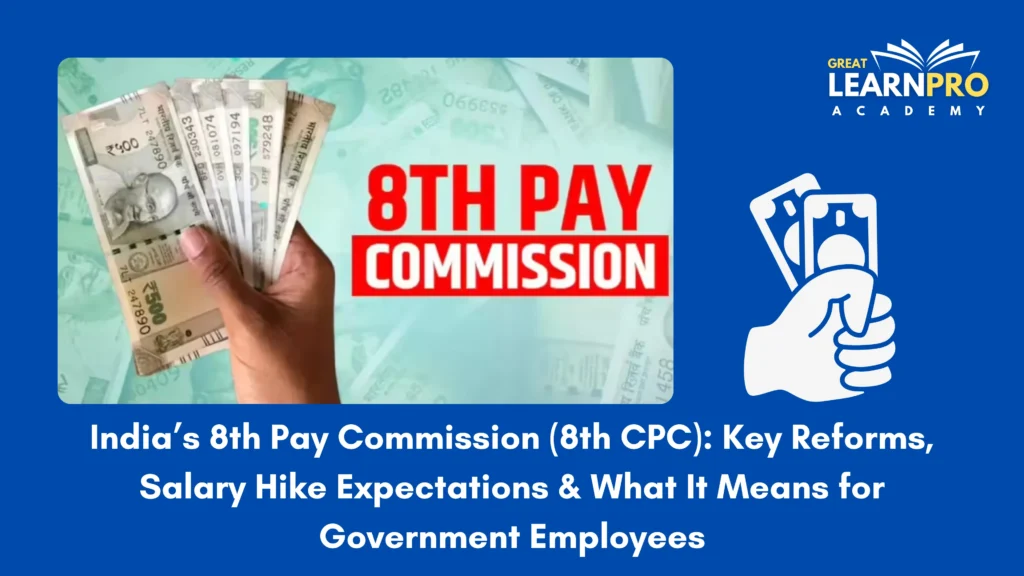The constitution of the 8th Central Pay Commission (8th CPC) marks a significant milestone in India’s administrative and fiscal landscape. To grasp its importance, it is useful first to reflect on the broader institutional framework of pay commissions, the law that governs them, how they operate, and what the 8th CPC seeks to achieve.

Introduction to Pay Commissions
Since Independence, the Government of India has periodically constituted pay commissions to review and recommend changes to the pay structure, allowances, pensions, and other service conditions of central government employees. The idea is that roughly once every decade, a fresh panel examines how government remuneration should adapt to changing economic, social, and fiscal conditions.
These pay commissions are not governed by a single, specific Act of Parliament; rather, the Government of India issues a notification constituting a commission under its executive power. The terms of reference (ToR) of each commission define the scope of its mandate—basic pay review, fitment factor, allowances, pensions, and dearness relief.
Broadly, the process works as follows: the Government issues a notification appointing a Chairperson (often a retired Supreme Court judge) and members; the commission then prepares its report based on data and consultations with various stakeholders; finally, the Government considers the recommendations, modifies them if necessary, and issues implementation orders which determine the revised pay scales, allowances, and pensions.
From the 1st Pay Commission in 1946 to the 7th in 2014, each has progressively restructured the salary framework for government employees, ensuring parity, inflation adjustment, and modernization of the pay system.
The Legal and Institutional Basis
Although there is no dedicated “Pay Commissions Act,” the establishment and functioning of pay commissions derive their legitimacy from Articles 309 and 310 of the Constitution of India, which empower the Government to regulate the recruitment and conditions of service of its employees. The executive order constituting each commission has the force of law once accepted by the Cabinet.
Once recommendations are accepted, they are implemented through the Central Civil Services (Revised Pay) Rules and corresponding pension rules, making them legally binding on all ministries and departments. Additionally, since many states mirror central recommendations, the Pay Commission has a wider fiscal impact across the country.
The 8th Central Pay Commission — What’s New?
On 16 January 2025, the Union Cabinet approved the constitution of the 8th Central Pay Commission, bringing relief and renewed anticipation to over 50 lakh central government employees and nearly 65 lakh pensioners. This decision comes nearly a decade after the 7th Pay Commission, which was implemented from January 1, 2016.
The 8th CPC will comprehensively review the pay structure, allowances, and pension system for all central government employees. Its key focus areas include inflation adjustment, cost of living, economic productivity, and fiscal sustainability.
A crucial element expected in the 8th CPC’s deliberations is the fitment factor, which determines the multiplication rate applied to existing basic pay to calculate revised pay levels. The 7th CPC had recommended a factor of 2.57, and early estimates suggest that the new factor may rise to 2.86 or more, reflecting inflation and economic growth over the past decade.
The commission is expected to submit its report within 18 months of formation, and its implementation is likely to take effect from 1 January 2026. However, considering previous experiences, complete implementation may extend into 2027 or 2028, depending on administrative and fiscal readiness.
The commission will also look into emerging issues like contractual staff remuneration, parity between different departments and defence personnel, rationalization of allowances, and pension relief amid rising inflation.
Why the 8th CPC Matters
The 8th Pay Commission is more than just a pay revision exercise—it represents an institutional recalibration of how India values its public servants. In an era of rising inflation, digital governance, and expanded administrative duties, fair remuneration is key to attracting and retaining skilled personnel.
The fiscal impact, however, will be significant. The 7th CPC alone increased the central government’s annual expenditure by over ₹1 lakh crore. With more employees and pensioners now covered, the 8th CPC’s recommendations could have a far larger impact. For employees and pensioners, a higher pay matrix will translate into improved living standards and better post-retirement security. For the economy, the ripple effect of higher consumption spending could boost demand across sectors.
Yet, balancing employee welfare with fiscal prudence remains crucial. The government must ensure that pay hikes do not compromise capital expenditure or widen the fiscal deficit.
Challenges and the Road Ahead
While the Cabinet’s approval has generated optimism, challenges remain. The formulation of terms of reference, consultation with states and ministries, and the collection of data on inflation, parity, and productivity are time-consuming. Historically, pay commissions have taken two to three years from setup to implementation.
Moreover, the 8th CPC will need to navigate the delicate balance between ensuring fair compensation and maintaining economic sustainability. With India’s economy expanding and public sector roles evolving, the recommendations will likely emphasize performance-linked pay, modernization, and better integration of digital work practices.
Conclusion
The 8th Central Pay Commission marks a pivotal moment in India’s governance and economic planning. It symbolizes the government’s commitment to fair compensation for public service while recognizing the fiscal realities of a growing economy. If executed efficiently, with transparency and fiscal balance, the 8th CPC could set new benchmarks for administrative reform and employee welfare ushering in a more equitable and efficient public service structure in India.
Sources:
- https://m.economictimes.com/news/economy/policy/8th-pay-commission-gets-cabinet-nod-implementation-likely-from-january-2026/articleshow/124881951.cms?ut
- https://timesofindia.indiatimes.com/business/india-business/govt-sets-up-3-member-panel-to-revise-pay-pension-of-1-2-crore/articleshow/124882802.cms?utm_
- https://indianexpress.com/about/8th-pay-commission/?utm_
More Current affairs: https://learnproacademy.in/updates/
